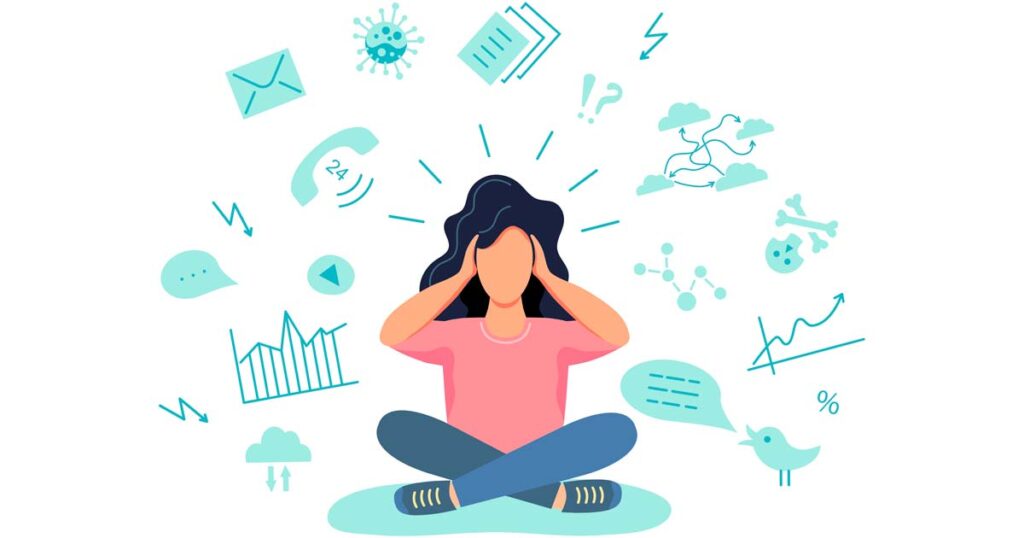What Is Somatic Awareness?
At its core, somatic awareness is about being aware of the physical sensations in your body. It involves the practice of noticing and tuning in to the physical sensations within your body. It’s different from just “thinking about” your body or symptoms. Instead, it’s about cultivating a present-moment awareness of your body’s signals without attaching a story or judgment to them. Involves mostly noting and being with the experience without judgment.
You might notice things like tension in your shoulders, a warmth sensation, butterflies in the stomach, the way your feet feel against the floor, or even the rise and fall of your breath.
It’s a bit like developing a dialogue with your body—one where you’re paying attention to its signals and sensations rather than ignoring or overriding them. Our bodies are constantly sending us messages, and somatic awareness is about learning to listen.
If you live with a chronic illness or ongoing pain, you know how challenging it can be to stay grounded in your body without becoming overwhelmed by symptoms. However, somatic awareness offers a path to reconnect with your body in a way that can ease discomfort and promote healing. It helps you observe sensations with curiosity rather than fear, allowing you to create a new relationship with your body—one that supports healing instead of amplifying discomfort.
A gateway to your inner state

Somatic awareness is the capacity to be mindful of internal bodily states. It goes beyond just noticing surface-level sensations (such as a muscle ache or a stomach rumble) and extends to a deeper, more refined sense of internal experience. This could include the awareness of breathing patterns, heart rate, posture, or even the subtle sensation of emotional states manifesting physically (such as tightness in the chest during anxiety or a flutter in the stomach when excited).
Somatic awareness often operates subconsciously but can be brought into conscious focus through practices such as mindfulness, meditation, yoga, or certain forms of psychotherapy. It is distinct from somatization, where bodily sensations are misinterpreted as signs of illness, often leading to anxiety and distress.
The only way to experience reality directly is to look within ourselves. We have all been conditioned to look outward. We are always interested in what is happening outside, what others are doing and rarely try to examine ourselves, our own mental, emotional and physical states. Therefore we remain unknown to ourselves. Somatic awareness presents a chance to really examine and become aware of who we truly are and gives us a sneak peek into the ever changing nature of existence which is manifested in our own physical bodies. Somatic awareness practices help us build resilience in an ephemeral universe that helps us bounce back easily from life challenges.
Somatic awareness promotes healing

You might be wondering, “Why Is Somatic Awareness So Important? “ “Why should I focus on my body’s sensations?” Well, there are many benefits to somatic awareness that go beyond just feeling more present. Most importantly, somatic awareness promotes healing.
Our bodies have a remarkable ability to heal themselves, but that process works best when we’re not in a constant state of tension, fear or fight-or-flight. Somatic awareness helps us relax and create space for the body to do what it’s naturally designed to do—heal. Whether it’s soothing chronic pain or supporting recovery from illness, this practice can be a powerful ally in your healing journey.
Benefits to your brain

1. Insular Cortex (Insula) Activation
The insula plays a crucial role in interoception, which is the perception of internal bodily states, such as heart rate, respiration, and visceral sensations. Information about these bodily states is vital to our health, wellbeing and even survival as it alerts us to the need for action.
Enhanced somatic awareness, such as in practices like mindfulness or meditation, has been associated with increased size of gray matter density in the insular cortex.
This leads to improved detection and regulation of bodily states leading to better self and emotional regulation.
2. Prefrontal Cortex (PFC) Stimulation
The PFC is associated with higher cognitive functions, including decision-making, attention, and the regulation of emotional responses to bodily sensations.
Individuals with heightened somatic awareness, particularly through meditation or mindfulness, have been shown to have increased cortical thickness in the PFC resulting in enhanced emotional regulation, better decision-making, and improved coping strategies for stress.
3. Reduction on Amygdala Volume and Reactivity
The amygdala is involved in emotional processing, especially fear and stress responses.
Meditation and mindfulness, which enhance somatic awareness, have been linked to reduced amygdala volume over time.
This reduces amygdala reactivity which may be associated with lower levels of stress, fear and anxiety tied to bodily sensations. This leads to reduced emotional reactivity and stress responses and builds emotional resilience.
Benefits to your Mental and Emotional health

Somatic awareness has a profound impact on mental and emotional health. Since emotions are often experienced physically in the body, being attuned to somatic sensations can help individuals better understand their emotional states and manage them more effectively.
1. Emotional Balance and Regulation:
By connecting with your body’s sensations, you can also tap into deeper emotional awareness by learning how emotions manifest in the body. Feelings often manifest physically. For example, anger as clenched fists, sadness as a heavy chest, excitement as an expansion in the chest expansion, fear as butterflies in the stomach.
When we recognize these signs early, we can process emotions in a more grounded, compassionate way before emotions escalate. It allows us to pause, breathe, and respond more consciously.
Somatic awareness also helps people better manage the emotional impact of chronic illness. According to a study in The Journal of Behavioral Medicine, individuals with chronic health conditions who engaged in body-based mindfulness practices saw improvements in emotional regulation, including reduced depressive symptoms and better coping mechanisms.
2. Mental resilience: Reduction of Anxiety and Stress:
Research published in Psychosomatic Medicine found that somatic practices like body scanning and mindful/conscious movement helped patients with chronic conditions reduce stress and anxiety, which in turn lessened physical symptoms.
By focusing on bodily sensations, individuals can shift attention away from ruminative thoughts and anchor themselves in the present moment. By calming the nervous system through somatic awareness, the body moves out of a constant state of “fight-or-flight” triggered by fear and stress and into a state that supports healing .
3. Improved Mind-Body Integration:
The mind and body influence each other in a bidirectional way. Our body sensations are deeply intertwined with emotional states, cognitive processes, and physiological responses. By utilizing this interconnection, Somatic awareness improves mental health, emotional well-being, and physical functioning. It helps individuals process traumatic experiences and unresolved emotional pain that may have been stored in the body.
Benefits to your Physical Health

Somatic awareness can also have significant physical health benefits. The connection between mind and body means that improving body awareness can lead to enhanced physical and mental well-being.
1. Pain Management:
Pain is an unpleasant sensory and emotional experience often linked to tissue damage, though it can sometimes occur without any actual injury. Pain is not purely physical; it also involves emotional, psychological, and cognitive elements. This means that chronic pain does not always indicate that tissue damage is present and may denote underlying psychological and emotional issues.”
A 2020 study published in Pain Medicine found that individuals practicing body awareness techniques, including somatic awareness, experienced a significant reduction in chronic pain symptoms. Participants reported that by becoming more attuned to their bodily sensations, they were able to release some of the tension and stress that often exacerbates chronic pain.
Somatic awareness practices have also been shown to reduce the perception of pain by altering the brain’s processing of painful sensations. By focusing attention on the sensation of pain without judgment, individuals can reduce their emotional reaction to pain, leading to a more manageable experience.
2. Improved Posture and Movement:
Somatic awareness helps individuals become more mindful of their posture, alignment, and movement patterns. This can prevent injuries, alleviate chronic tension, and promote a sense of ease and efficiency in daily activities.
When we become more aware of our posture, movements, and how we hold tension, we can make subtle adjustments that prevent long-term issues like back pain, headaches, or muscle fatigue. Somatic awareness can help you develop a better relationship with your body, promoting healthier habits and alignment.
3. Autonomic Nervous System Regulation:
Somatic awareness can help regulate the autonomic nervous system, which controls functions such as heart rate, digestion, and breathing. Techniques that increase body awareness, such as mindful breathing, can activate the parasympathetic nervous system, leading to a state of relaxation and recovery. This has positive effects on cardiovascular health, digestion, immune function, and overall physical vitality.
Increasing Somatic Awareness for Managing Chronic Health Conditions and Physical Symptoms

The good news is that somatic awareness doesn’t require complex or time-consuming exercises. In fact, small moments of awareness integrated throughout your day can have a profound impact on how you feel.
Here are five simple practices and exercises that will help you connect with your body and create a sense of safety and ease.
1. Body Scan: A Moment of Mindful Check-In
Body scan practices involve mentally scanning the body from head to toe, bringing focused awareness to different parts of the body and noticing any sensations, tension, or discomfort without judgment.
Find a quiet place where you can sit or lie down comfortably. Close your eyes and take a few deep breaths. Now, bring your attention to the top of your head, and slowly begin to scan down through your body. Notice how each part feels without trying to change anything.
Do you feel any tension, take note of any areas that feel tight, relaxed, warm, or cool. You’re simply observing and being with the experience and this alone helps you reconnect with your body.
You can do a body scan in as little as 2–5 minutes, making it a perfect practice for those short breaks during the day.
Research suggests that body scans can lower stress levels and reduce physical symptoms in individuals with chronic pain .
Get access to guided body scan practices through the mind medicine App.
2. Breath Awareness: Calming the Nervous System
Breath awareness is one of the simplest and most effective somatic practices for people with chronic health issues. When we focus on our breath, we activate the parasympathetic nervous system, which helps our body move out of “fight-or-flight” and into a state of rest, digest and repair.
Sit comfortably and simply bring your awareness to your breath. Notice the rise and fall of your chest or belly with each inhale and exhale. You don’t need to change anything—just observe the rhythm of your breathing. After a few minutes, you’ll likely notice a sense of calm washing over your body.
Get access to guided meditative breathing practices through the mind is medicine App.
3. 5-4-3-2-1 Sensory Grounding
Sensory grounding helps you connect with your senses, which can be incredibly useful when dealing with pain or distressing symptoms. It also redirects your attention from your mind to the sensory information around you.
Here’s how to do it:
- Name 5 things you can see around you.
- Name 4 things you can feel—perhaps the texture of your clothes or the warmth of your hands.
- Name 3 things you can hear—the hum of a fan, distant voices, or birds outside.
- Name 2 things you can smell—even if it’s just the fresh air.
- Name 1 thing you can taste—this might be the lingering taste of your last meal or sip of water.
This exercise can quickly shift your focus away from painful sensations and ease anxious thinking.
4. Progressive muscle relaxation: Releasing Tension
Progressive muscle relaxation consists of learning to sequentially tense and then relax various groups of muscles, all through the body from head to toe. The practice is a gentle, mindful way of checking in with your body and releasing tension where it’s no longer needed. Find a comfortable position to lay down, close your eyes and sequentially tense then relax your muscles.
With this practice, you can discover which areas of your body routinely tighten up when you’re anxious or stressed and can relax those areas by deliberately attending to them regularly.
Relaxing your muscles activates the parasympathetic nervous system which is our rest and digest system that promotes healing.
Get access to guided progressive muscle relaxation practices through the mind is medicine App.
5. Sensing Through Your Feet: Grounding Practice
This is an ideal exercise when you feel overwhelmed by your symptoms or racing thoughts. Sit comfortably with both feet flat on the floor. Close your eyes if it feels comfortable, and bring all your attention to the soles of your feet.
Notice the texture of the surface beneath your feet, the weight of your feet pressing down, and the sensation of any movement—like shifting weight. Stay with these sensations for a minute or two. By focusing on the sense of physical connection between your body and the ground, you’re helping to “ground” your nervous system and bring yourself back into the present moment.
6. Somatic tracking
This involves focusing on a single or a couple of Sensations and following them through time to see how they change.
It’s all about learning and recognizing the factors that trigger, exacerbate and relieve the specific body sensation.
Get access to a guided somatic awareness practice through the mind is medicine App.
Conclusion: Listening to Your Body as a Path to Healing

Somatic awareness can help you find fulfillment despite dealing with a chronic illness. It can be a transformative tool for managing physical symptoms, reducing fear & stress, and supporting your body’s healing process.
Next Steps
The research is clear: by developing a deeper, kinder relationship with your body through somatic practices, you can significantly improve mental, physical and emotional health. Somatic awareness invites you to slow down, tune in, and notice the subtle (and sometimes not-so-subtle) ways your body communicates with you. Your body is always speaking to you—all you have to do is listen.
I encourage you to try out these practices with the support of Mind is Medine APP here and see how they feel for you.
It is not about achieving perfection; it’s about meeting your body where it is, with patience and compassion. Over time, you may find that this simple practice becomes a powerful ally in your healing journey.
Even small moments of awareness can make a big difference in how you feel, both physically and emotionally.
Take care of your body—it’s your most faithful companion.



